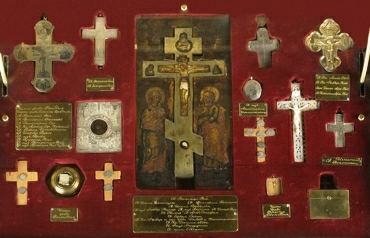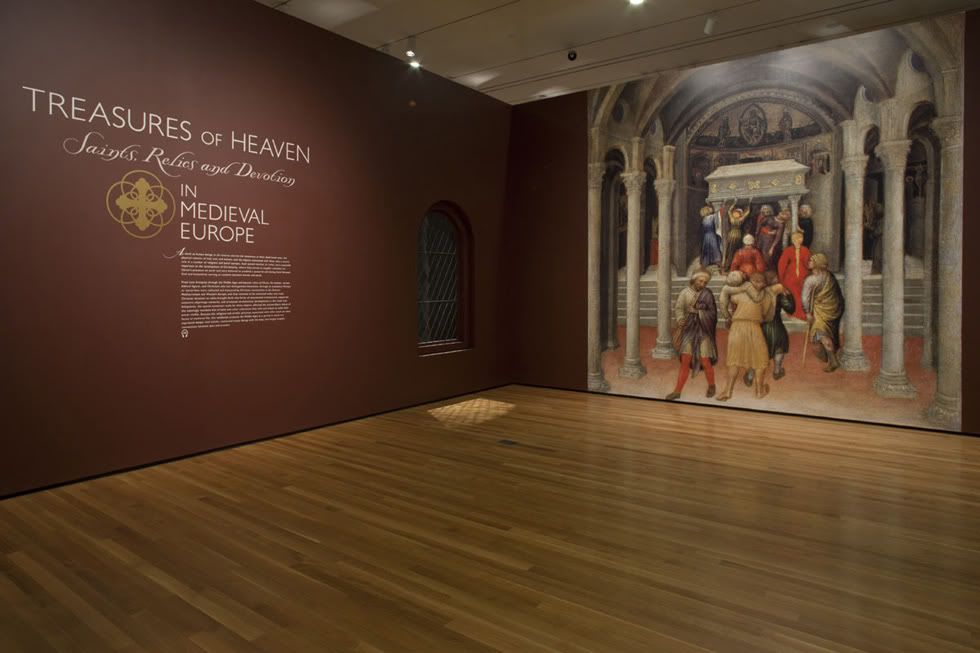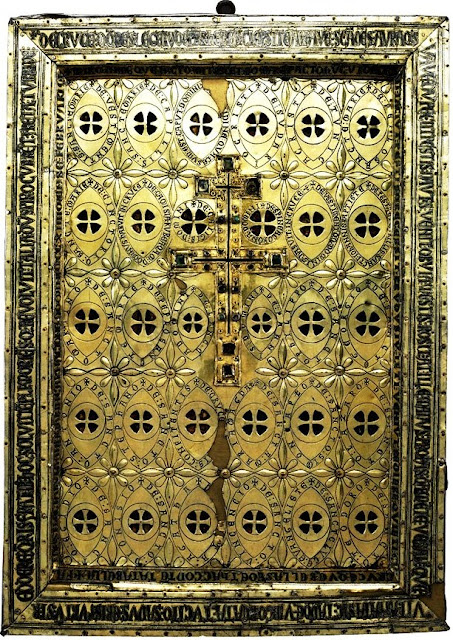Неизвестная часть Пояса Богородицы
От редакции. 20 октября 2011 г. в нашем музейном блоге была опубликована статья об истории честного Пояса Пресвятой Богородицы, которая была подготовлена к принесению части Пояса, хранящейся на Святой горе Афон в Россию: http://expertmus.livejournal.com/84029.html
Эту статью перепечатали у себя многие российские СМИ как печатные, так и электронные, в т.ч. церковные издания. Так, 23 ноября 2011 г. статья появилась на сайте Новосибирской и Бердской епархии Русской Православной Церкви: http://www.orthedu.ru/news/3946-poyas_bogorodicy_vsya_istoriya_bez_kupyur.html Но вскоре (по отмашке сверху?) была заскринена … Это что же за цензура такая и сокрытие информации о святыне от верующих?! К слову сказать, целый ряд околопатриархийных сайтов позаимствовали не только фактические данные, но даже фото из статьи в музейном блоге, даже не сославшись на первоисточник, т.е. попросту говоря стащили. Хороши же нравы в ведомстве Легойды: http://expertmus.livejournal.com/86997.html
Нужно подчеркнуть, что редакционная статья о Поясе Богородицы была размещена в блоге именно с целью предоставить всем верным чадам Русской Православной Церкви точные и ПОЛНЫЕ сведения о святыне. В то же время следует признать, что редакции блога пришлось в силу известных причин не указывать о нахождении в Москве еще одной части Пояса, раз об этом умолчали организаторы принесения:-(

К сожалению, сбылись самые худшие опасения и лишь на пике массового психоза клир ХХС и оргкомитет соизволили оповестить верующих о сем факте, но лишь … 23 ноября 2011 г. Действительно, частица от афонского Пояса Пресвятой Богородицы, привезенная в Россию в ХХ веке, давным-давно хранится в мощевике, находящемся в приделе апостолов Петра и Павла, в церкви пророка Илии в Обыденном переулке: http://rublev-museum.livejournal.com/257681.html
Напомним, что когда с Кипра в Болгарию в июне 2011 г. был прислан для поклонения хранящийся там честный Пояс Девы Марии, то никакого массового психоза не было, всё прошло благочинно, и у верующих «братушек» было вполне достаточно информации о святыне: http://expertmus.livejournal.com/84029.html
Имея печальный опыт «взаимодействия» с рядом околопатриархийных СМИ, редакция решила временно «придержать» в статье, опубликованной в музейном блоге, кое-какие дополнительные сведения о местонахождении частей Пояса Богородицы с тем, чтобы вывести на чистую воду недобросовестных журналюг, таскающих из блога эксклюзивную информацию без ссылок на источник публикации. Теперь, когда по многим изданиям разошлась «справка о 14 местах, где в современном мире хранятся пояс Богородицы или его фрагменты», вниманию всех заинтересованных читателей предлагается ранее неизвестная даже для специалистов информация о святыне. Таким образом, каждый желающий легко сможет установить, кто и как заимствует материал для «своих» публикаций:-)
Еще одну часть Пояса Богородицы можно было увидеть на замечательной выставке в Британском музее «Treasures of Heaven: Saints, Relics, and Devotion in Medieval Europe» (June 23, 2011 - October 9, 2011), о которой практически умолчали в российских СМИ: http://rublev-museum.livejournal.com/109629.html

Познакомиться своевременно с экспонатами, среди которых немалая часть раннехристианских и средневековых святынь (см. видео вверху), смогли лишь постоянные читатели сообщества rublev-museum по целому ряду статей: «Treasures of Heaven at the British Museum» http://rublev-museum.livejournal.com/153748.html, «Installing Treasures of Heaven» http://rublev-museum.livejournal.com/148583.html etc.

Panel-shaped Reliquary of the True Cross
The Cleveland Museum of Art, purchase from the J. H. Wade Fund
Culture: Cross: Latin Kingdom of Jerusalem; panel: Rhine-Meuse region
Date: 1214
Material: Silver, silver gilt over wood (walnut), precious stones, niello
Dimensions: 41.6 × 30.2 cm
Inscribed: +de vestimentis sanct(a)e mari(a)e (of the vestments of the Virgin Mary); +de capillis sanct(a)e mari(a)e (of the hair of the Virgin Mary); +(de sin)dine qua cesvm est capvt domini (of the shroud that covered the head of Christ); +de svdario cristi (of Christ's sudarium); +de tvnica cristi (of Christ's tunic); +de peplo sanct(a)e mari(a)e (of the Virgin's peplos); +de cinctorio sanct(a)e mari(a)e (of the Virgin's belt); +de camisia rvbea q(u)am dominvs habvit in crvce (of the red chemise that the Lord wore on the Cross); +de caligis domini (of the Lord's sandals); +de spinea corona domini (of the Lord's crown of thorns); +de vestimento q(uod) dominis habvit in crvce (of the Lord's garment which he wore on the Cross); +de testa et carillis sancti iohannis baptiste (of the head and hair of St. John the Baptist); +de sancto martino (of St. Martin); +de peplo sanct(a)e mari(a)e (of the Virgin's peplos); +de lancea domini (of the lance of the Lord); +de pannis dominis (of the Lord's swaddling clothes); +de sancto philippo (of St. Philip); +de sancto georgio (of St. George); +de sancto antonio (of St. Anthony); +de sancto stephano (of St. Stephen); +de crvce (latron)is confitentis (of the Good Thief's cross); +de sancto maria magdal(ena) (of St. Mary Magdalene); +de sancto simon capel(l)o (of St. Simon's hair); +de sancto lazaro (of St. Lazarus); +de sancto egidio (of St. Giles); +de sancto dionisio (of St. Denis); +de sancta agatha (of St. Agatha); +de sancto vincencio (of St. Vincent); +de sancte [sic] lvc(a)e evangelist(a)e (of St. Luke the Evangelist); +de sancto teodoro (of St. Theodore) + de crvce q(v)i q(ve)res lege ivde p(res)b(ite)r heres / clepsit ea(m) nave(m) sca(n)de(n)s avra(m)q(ve) svave(m) / dv(m) peciit pestis navtis venit obvia mestis / rosit at ille manvs pror(r)ias q(v)a me(n)te vesan(vs) / qve(m) f/vit affata sic tande(m) virgo beata / tv cito sanvs eris fvrtv(m) si r/eddere q(ve)ris / fratrib(vs) hoc solvit te(m)pli morie(n)sq(ve) revolvit / talia dv(m) spiro cvrre(n)t frata tvrbine + miro / in me qve iacto mitescet eo mare pacto / hv(n)c vt decessit iaciv(n)t pestisq(ve) recessit / brv(n)dvsiv(m) leti veniv(n)t rediere qvieti / cv(m) crvce qve bella sedet hac conte(n)ta tabella / + facta est h(a)ec tabvla anno ab incarnatione domini mccxiiii mense fabrvarij + (+You who ask about the cross: read! The heir of Judas the priest / Stole it. But when, after boarding a ship, / He sought a mild breeze, a fierce storm opposed the sorry sailors. / Out of his mind, he gnawed at his own hands. / In the end the blessed Virgin spoke thus to him: / "You shall soon be well, if you seek to return what was stolen." / He pays back this debt to the brothers of the Temple, / And as he was dying, he turned over such [thoughts in his mind]: / "As long as I breathe, the waves shall flow, with a wondrous whirlwind laid against me, / But when this is settled, the sea shall grow calm." / When he died, they cast him overboard, and the storm subsided. / Happy they arrive at Brindisi, quiet they have returned with the cross, / Which resides beautiful in this handsome panel. + This tablet was created in the 1214th year from the Lord's incarnation in the month of February +)
Provenance: purportedly from Cologne Cathedral; Albin Chalandon, Lyon; Georges Chalandon, Paris; Adolph Loewi, Los Angeles
This panel-shaped reliquary follows a format commonly associated with Byzantine staurothekai, or reliquaries of the True Cross. Soon after the Crusader conquest of Constantinople in 1204, which resulted in the transfer of a number of distinguished Byzantine reliquaries of this type, Western artists-especially in the Rhine-Meuse region-started to adopt such Byzantine reliquary formats for their own purposes, thus fusing Eastern and Western metalworking techniques and traditions.
The Cleveland reliquary is one of the most striking examples of such an artistic fusion. A lengthy Latin inscription, executed in niello, frames the reliquary's central panel in two layers on all four sides. It records the colorful history of the translation of the relic of the True Cross, displayed prominently at the reliquary's center. While the inscription itself does not reveal where and under what circumstances the cleric named in the translatio account stole the relic, the design of the silver-gilt, double-arm cross- which is, in fact, only the front face of a reliquary cross-points toward the Latin Kingdom of Jerusalem as its place of origin. Likewise unknown is the exact location where the panel-shaped reliquary with its thirty additional relics of Christ, the Virgin, John the Baptist and other important saints and martyrs was manufactured. The overall arrangement of these additional relics around the double-arm cross relic as well as the placement of the framing inscription seems to indicate a knowledge of the famous Byzantine staurotheke that Henry of Ulmen brought back with him to the Rhineland from Constantinople in 1207 (now in the cathedral treasury of Limburg an der Lahn), where it served as a highly influential model for local goldsmiths for several decades.
© Блог научного коллектива Музея имени Андрея Рублева. Эксперты приводят в пример воцерковлённое сообщество - сообщество Музея древнерусской культуры и искусства имени Андрея Рублёва: http://rublev-museum.livejournal.com/392705.html
Tags: Русская Православная Церковь, досье, расследование, фальсификация истории
Метки: #Музей, #МузейАндреяРублева, #МузейРублева, #МузейноеЕдинство, #музей_имени_Рублева, #протест, Музей имени Андрея Рублева, СМИ о ЦМиАР, досье, расследование
#МузейРублева #МузейАндреяРублева #музей_имени_Рублева #МузейноеЕдинство #rublevmuseum #andreyrublevmuseum
@ Музей Андрея Рублева